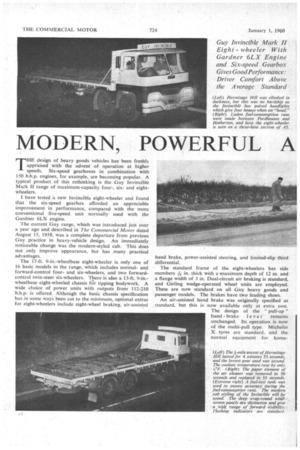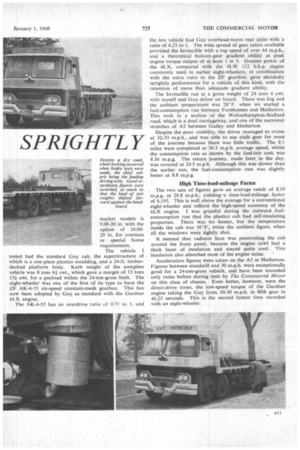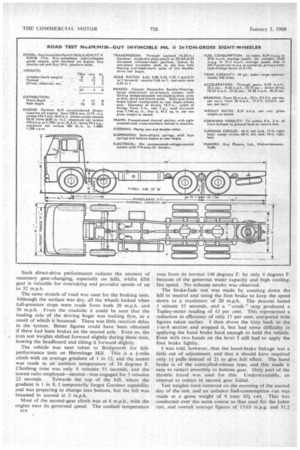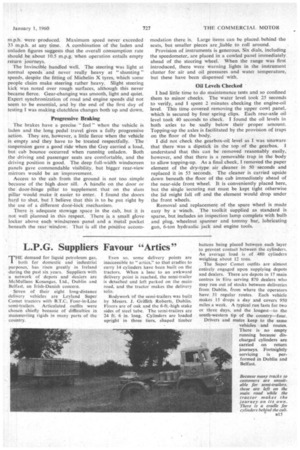MODERN, POWERFUL A SPRIGHTLY
Page 46

Page 47

Page 48

Page 49

If you've noticed an error in this article please click here to report it so we can fix it.
THE design of heavy goods vehicles has been freshly appraised with the advent of operation at higher speeds. Six-speed gearboxes in combination with 150 b.h.p. engines, for example, are becoming popular. A typical product of this rethinking is the Guy Invincible Mark II range of maximum-capacity four-, sixand eightwheelers.
I have tested a new Invincible eight-wheeler and found that the six-speed gearbox afforded an appreciable improvement in performance, compared with the more conventional five-speed unit normally used with the Gardner 6LX engine.
The current Guy range, which was introduced just over a year ago and described in The Commercial Motor dated August 15, 1958, was a complete departure from previous Guy practice in heavy-vehicle design. An immediately noticeable change was the modern-styled cab. This does not only improve appearance, but has many practical advantages.
The 17-ft. 9-in.-wheelbase eight-wheeler is only one of 16 basic models in the range, which includes normaland forward-control fourand six-wheelers, and two forwardcontrol twin-steer six-wheelers. There is also a 13-ft. 9-in.wheelbase eight-wheeled chassis for tipping bodywork. A wide choice of power units with outputs from 112-210 b.h.p. is offered. Although the basic chassis specification has in some ways been cut to the minimum, optional extras for eight-wheelers include eight-wheel braking, air-assisted hand brake, power-assisted steering, and limited-slip third differential.
The standard frame of the eight-wheelers has side members in. thick with a 'maximum depth of 12 in. and a flange width of 3 in. Dual-circuit air braking is standard, and Girling wedge-operated wheel units are employed. These are now standard on all Guy heavy goods and passenger models. The brakes have two leading shoes.
An air-assisted hand brake was originally specified as standard, but this is now available only at extra cost. The design of the " pull:up " hand brake lever remains unchanged. Its operation is now of the multi-pull type. Michelin X tyres are standard, and the normal equipment for home market models is 9.00-20 in. with the option of 10.0020 in. for overseas or special home requirements.
The vehicle I tested had the standard Guy cab, the superstructure of which is a one-piece plastics moulding, and a 24-ft. timberdecked platform body. Kerb weight of the complete vehicle was 8 tons 61 cwt., which gave a margin of 15 tons 131 cwt. for a payload within the 24-ton-gross limit. The eight-wheeler was one of the first of its type to have the ZF .AK-6-55 six-speed constant-mesh gearbox. This has now been adopted by Guy as standard with the Gardner 6LX engine.
The AK-6-55 has an overdrive ratio of 0.71 to 1, and the test vehicle had Guy overhead-worm rear axles with a ratio of 6.25 to 1. The wide spread of gear ratios available provided the Invincible with a top speed of over 44 m.p.h., and a theoretical bottona-gear gradient ability at peak engine torque output of at least I in 5. Greater power of the 6LX, compared with the 6LW 112 b.h.p. engine commonly used in earlier eight-wheelers, in combination with the extra ratio in the ZF gearbox, gave decidedly sprightly performance for a vehicle of this kind, with the retention of more than adequate gradient ability.
The Invincible ran at a gross weight of 24 tons 4 cwt. withmyself and Guy driver on board. There was fog and the ambient temperature was 28°F. when we started a fuel-consumption run between Fordhouses and Hatherton. This took in a section of the Wolverhampton-Stafford road, which is a dual carriageway, and one of the narrower stretches of A5 between Gailey and Hatherton.
Despite the poor visibility, the driver managed to cruise at 32-33 m.p.h., and was able to use sixth gear for most of the journey because there was little traffic. The 8.1 miles were completed at 30.5 m.p.h. average speed, whilst the consumption rate as shown by the fuel-test tank was 8.36 m.p.g. The return journey, made later in the day, was covered at 29.5 m.p.h. Although this was slower than the earlier run, the fuel-consumption rate was slightly better at 8.8 m.p.g.
High Time-load-mileage Factor
. The two sets of figures gave an average result of 8.59 m.p.g. at 29.8 m.p.h., yielding-a time-load-mileage factor of 6,195. This is well above the average for a conventional eight-wheeler and reflects the high-speed economy of the 6LX engine. I was grateful during the outward fuelconsumption run that the plastics cab had self-insulating properties. There was no heater, but the temperature inside the cab was 56°F., twice the ambient figure, when all the windows were tightly shut.
It seemed that radiator heat was penetrating the cab around the front panel, because the engine cowl had a thick layer of insulation and stayed quite cool. This insulation also absorbed most of the engine noise. •
Acceleration figures were taken on the A5 at Hatherton. Figures between standstill and 30 m.p.h. were exceptionally good for a 24-ton-gross vehicle, and have been exceeded only twice before during tests by The Commercial Motor on this class of chassis. Even better, however, were the direct-drive times, the low-speed torque of the Gardner engine taking the Guy from 10-30 m.p.h. in fifth gear in 46.25 seconds. This is the second fastest time recorded with an eight-wheeler.
Such direct-drive performance reduces the amount of necessary gear-changing, especially on hills, whilst fifth gear is valuable for overtaking and provides speeds of up to 32 m.p.h.
The same stretch of road was used for the braking tests. Although the surface was dry, all the wheels locked when full-pressure stops were made from both 20 m.p.h. and 30 m.p.h. From the roadside it could be seen that the leading axle of the driving bogie was locking first, as a result of which it bounced. There was little reaction delay in the system. Better figures could have been obtained if there had been brakes on the second axle. Even so, the iron test weights shifted forward slightly during these tests, bowing the headboard and tilting it forward slightly.
The vehicle was next taken to Bridenorth for hillperformance tests on Hermitage Hill. This is a 1-mile climb with an average gradient of 1 in 12, and the ascent was made in an ambient temperature of 34 degrees F. Climbing time was only 4 minutes 55 seconds, and the lowest ratio employed-second-was engaged for 3 minutes
22 seconds. Towards the top of the hill, where the gradient is 1 in 8, 1 temporarily forgot Gardner capability and was preparing to change into bottom, but the hill was breasted in second at 2 m.p.h.
Most of the second-gear climb was at 6 m.p.h., with the engine near its governed speed. The coolant temperature 814 rose from its normal 148 degrees F. by only 4 degrees F. because of the generous water capacity and high coolingfan speed. No exhaust smoke was observed.
The brake-fade test was made by coasting down the hill in neutral and using the foot brake to keep the speed down to a maximum of 20 m.p.h. The descent lasted 1 minute 55 seconds, and a "crash" stop produced a Tapley-meter reading of 43 per cent. This represented a reduction in efficiency of only 17 per cent, compared with figures taken earlier. I then drove the Guy back to the 1-in-8 section and stopped it, but had some difficulty in applying the hand brake hard enough to hold the vehicle. Even with two hands on the lever I still had to apply the foot brake lightly.
I was told, however,, that the hand-brake linkage was a little out of adjustment, and that it should have required only 11 pulls instead of 21 to give full effect. The hand brake is of the controlled-release type, and this made it easy to restart smoothly in bottom gear. Only part of the throttle travel was used for this. Understandably, an attempt to restart in second gear failed.
Test weights were removed on the morning of the second day of the test, and an unladen fuel-consumption run was made at a gross weight of 8 tons 101 cwt. This was conducted over the same course as that used for the laden run, and overall averaae figures of 13.65 m.p.g. and 31.2 m.p.h. were produced. Maximum speed never exceeded 33 m.p.h. at any time. A combination of the laden and unladen figures suggests that the overall consumption rate should be about 10.5 m.p.g. when operation entails empty return journeys.
The Invincible handled well, The steering was light at normal speeds and never really heavy at " shunting " speeds, despite the fitting of Michelin X tyres, which some people claim make steering rather heavy. Slight steering kick was noted over rough surfaces, although this never became fierce. Gear-changing was smooth, light and quiet. Expert synchronization of road and engine speeds did not seem to be essential, and by the end of the first day of testing I was making clutehless changes both up and down.
Progressive Braking
The brakes have a precise " feel " when the vehicle is laden and the long pedal travel gives a fully progressive action. They are, however, a little fierce when the vehicle is empty and they have to be treated respectfully. The suspension gave a good ride when the Guy carried a load, but cab bounce occurred when running unladen. Both the driving and passenger seats are comfortable, and the driving position is good. The deep full-width windscreen panels gave commendable visibility, but bigger rear-view mirrors would be an improvement.
Access to the cab from the ground is not too simple because of the high door sill. A handle on the door or the door-hinge pillar to supplement that on the slam pillar would make it easier to enter. I found the doors hard to shut, but I believe that this is to be put right by the use of a different door-lock meehanism.
There is adequate stowage space in the cab, but it is not well planned in this respect. There is a small glove locker above each windscreen panel and a metal pocket beneath the rear window. That is all the positive accom
modation there is. Large items can be placed behind the seats, but smaller pieces are Jiable to roll around.
Provision of instruments is generous. Six dials, including the speedometer, are placed in a cowled panel immediately ahead of the steering wheel. When the range was first introduced, there were warning lights in the instrument cluster for air and oil pressures and water temperature, but these have been dispensed with.
Oil Levels Checked I had little time to do maintenance tests and so confined them to minor cheeks. The water level took 25 seconds to verify, and I spent 2 minutes checking the engine-oil level. This time covered removing the upper cowl panel,. which is secured by four spring clips. Each rear-axle oil level took 40 seconds to check. I found the oil levels in both axles to be sadly below their proper amount. Topping-up the axles is facilitated by the provision of traps on the floor of the body.
I did not check the gearbox-oil level as I was unaware that there was a dipstick in the top of the gearbox. understand that this can be removed reasonably easily, however, and that there is a removable trap in the body to allow topping-up. As a final check, I removed the paper element of the dry-type air cleaner in 50 seconds and replaced it in 55 seconds. The cleaner is carried upside down beneath the floor of the cab immediately ahead of the near-side front wheel. It is conveniently placed here, but the single securing nut must be kept tight otherwise the lid might fall off and the element would drop under the front wheels.
Removal and replacement of the spare wheel is made easy by a' winch. The toolkit supplied as standard is sparse, but includes an inspection lamp complete with bulb and plug, wheelnut spanner and tommy bar, lubricating gun, 6-ton hydraulic jack and engine tools.




























































































